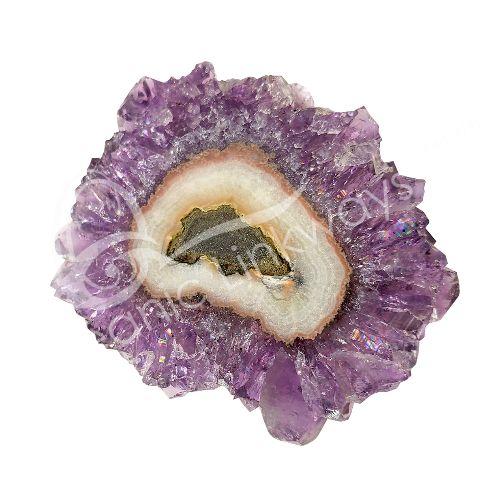Subscribe to our newsletter and get a coupon for 15% off your first order & free shipping!
Stalactite Slices Packaged
SKU 36259
$6.40
Sold out
was $8.00 Save 20%
Sold out
Product Details
Stalactite Slices Packaged
Sealed. Handle with care.
Mineral Information:
A stalactite is a mineral deposit that forms from the ceiling or roof of a cave, underground cavern, or other similar geological formations. It is a type of speleothem, which refers to secondary mineral formations found in caves.
Stalactites are created through a process known as dripstone formation. As water containing dissolved minerals, such as calcium carbonate, drips or seeps through cracks or porous rock formations, it leaves behind small amounts of mineral deposits. Over time, these deposits accumulate and grow downwards, forming icicle-like structures that hang from the ceiling.
The mineral-rich water that creates stalactites often comes from percolating through the soil and bedrock above the cave. As the water drips, it evaporates, and the dissolved minerals are left behind, gradually building up the stalactite. The minerals involved in stalactite formation can vary, but calcium carbonate is the most common, resulting in formations made of calcite or aragonite.
Stalactites can take on various shapes and sizes depending on the specific conditions and the rate of mineral deposition. They can appear as thin and delicate structures or grow to be thick and robust. Some stalactites have smooth surfaces, while others may have rough textures or be adorned with intricate mineral formations.
Stalactites often occur in conjunction with stalagmites, which are mineral deposits that grow upwards from the cave floor. Over time, stalactites and stalagmites can meet and form columns, creating unique and visually striking formations known as stalactite-stalagmite columns.
These formations can take thousands or even millions of years to develop, and they provide valuable insights into the geological history of an area. Stalactites are not only significant in terms of scientific study and cave exploration but are also admired for their natural beauty and captivating formations.
Metaphysical Meaning:
Stalactites are deeply rooted formations that grow from the ceiling of caves, representing a connection between the Earth and the celestial realm. Metaphysically, they are believed to provide grounding energy and promote a sense of stability, helping individuals stay connected to the present moment and the physical world. Stalactites are formed within the depths of the Earth and carry the energy and wisdom of the Earth element. They are believed to hold the vibrations of ancient knowledge and provide a link to the deep wisdom of the planet. Meditating or working with stalactites can help individuals tap into this wisdom, fostering a deeper connection to nature and the natural cycles of life.
Mineral Care:
A stalactite is fragile and requires careful handling and protection. The fragility of a stalactite can be attributed to several factors:
-
Delicate Mineral Structure: Stalactites are composed of minerals, usually calcium carbonate (calcite or aragonite) or other mineral deposits. These minerals have a crystalline structure that can be susceptible to damage. The fine crystal formations within the stalactite can be fragile and prone to breakage if subjected to force or impact.
-
Slow Growth: Stalactites are often formed over an extended period, sometimes taking thousands or even millions of years to develop. The slow growth process means that the stalactite's structure may not have the same strength and resilience as more rapidly formed formations. The gradual accumulation of minerals layer by layer can result in a delicate structure that requires careful handling.
-
Sensitivity to Environmental Changes: Stalactites are sensitive to changes in their environment. Fluctuations in temperature, humidity, or exposure to direct sunlight can impact the stability of the stalactite. Sudden shifts in these factors can cause stress on the structure, leading to cracks, fractures, or even complete breakage.
-
Vulnerability to Chemical Reactions: Stalactites are also vulnerable to chemical reactions. Exposure to acidic substances, such as acidic cleaning agents or environmental pollutants, can deteriorate the minerals comprising the stalactite. This chemical deterioration weakens the structure, making it more fragile and susceptible to damage.
Given the fragility of stalactites, it is essential to handle them with extreme care. Here are some precautions to keep in mind:
-
Minimize Physical Contact: Avoid touching or handling the stalactite with bare hands. The oils and moisture from your skin can harm the delicate mineral structure. Use gloves or handle the stalactite with a soft cloth to prevent direct contact.
-
Gentle Handling: When moving or transporting a stalactite, ensure it is adequately supported and cushioned to prevent any jarring or impact. Avoid dropping or subjecting it to sudden movements that can lead to breakage.
-
Stable Environment: Maintain a stable environment for the stalactite. Avoid exposing it to rapid temperature or humidity changes. Keep it away from direct sunlight, as prolonged exposure can cause fading or deterioration.
-
Protective Storage: Store the stalactite in a padded container or display case specifically designed to protect delicate minerals. This provides additional support and safeguards against accidental damage.
By following these precautions and treating stalactites with the utmost care, you can help preserve their beauty and integrity for extended enjoyment and appreciation.
Disclaimer:
No information here is intended to diagnose, treat or cure ailments or afflictions of any kind. One should always consult a medical professional if a serious issue presents itself.
Save this product for later
Stalactite Slices Packaged
Display prices in:USD

